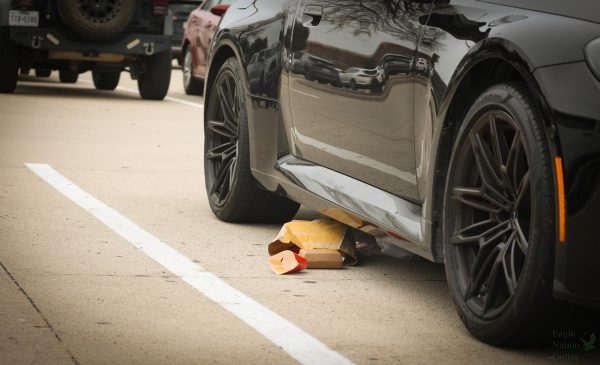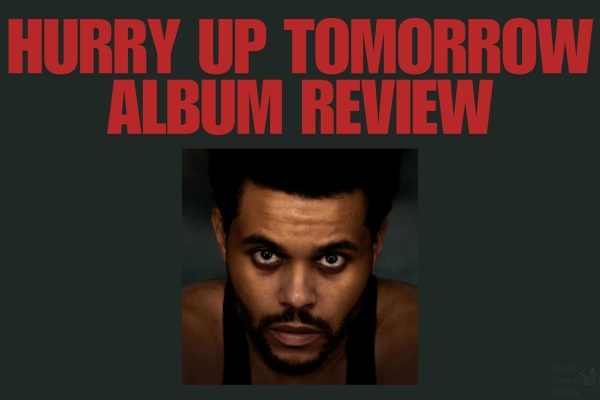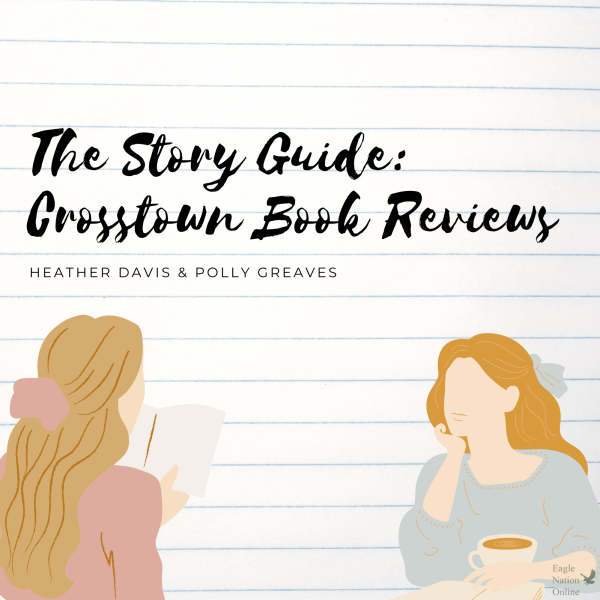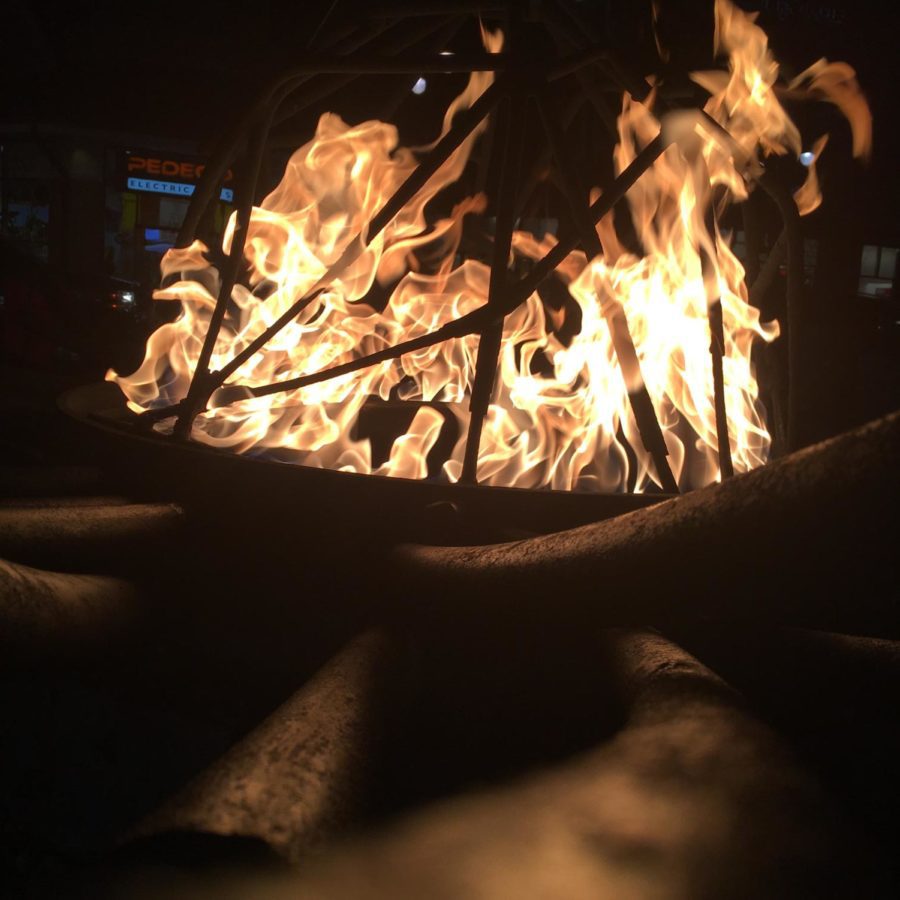Column: ‘The Suicide Disease’ – ‘At least it isn’t cancer’
A fire pit burns at Southlands Mall in Aurora, Colorado. Column author, Rin Jackson, took this photo years ago when she lived near there. Flames are a symbol for Complex Regional Pain Syndrome, as burning alive is considered a comparable pain. “Fire is the main descriptive word used as an attempt to summarize the pain,” Jackson said. “Pure fire.”
Writer presents reality of measurement of pain
Ten days before my tenth birthday, I was diagnosed with “the suicide disease.”
“Imagine going through your daily life where everything that you touch, or that touches you, where most every noise around you from a passing car or plane to children playing, causes you pain,” CRPS victim and founder of American RSDHope Keith Orsini said in description of the disease. Complex Regional Pain Syndrome, CRPS for short, sits at the very top of the McGill Pain Index. Arthritis is rated as less than half as painful, phantom limb pain as around three quarters, and unmedicated amputation a couple of points below. “The suicide disease” has, therefore, become a more common name for the disorder. Those with the disease are referred to as victims, as most will die from the disease – accurate and reliable statistics are impossible to find, but suicide is proven as the most common form of death for these patients. Join grieving family and friends in November for observation of CRPS awareness month.
About the disease
Traumatic injuries such as soft tissue damage or botched invasive surgery are the root of the problem. A select few gravely unfortunate souls are unable to forget the feeling and develop PTSD symptoms stretching far beyond the mind. Rather than mere flashbacks and insomnia, the infected area will waste away with nearly untreatable persistency, all thanks to faulty brain signals and in no part resulting from actual remaining physical damage, ultimately leaving the body with final damage similar to that of polio. Mind over matter sickeningly proves itself real. Fire is the main descriptive word used as an attempt to summarize the pain – pure fire. Burning alive.
Fewer than 200,000 victims worldwide, or about 0.0003% of the population, suffers from CRPS, making diagnosis a trying journey and often an unattainably lofty goal. Few doctors recognize the name, much less presence, leaving most patients long beyond the curable Stage 1 by the time they can find anyone who will not say it is simply in their head. Lack of treatment leaves over 70% of cases to spread and infect new portions of the victims body. Due to incurability, some patients will suffer all the way to Stage 4 – where amputation is a common practice – instead of ever again living a normal, happy life.
My story
I spent almost a year in a wheelchair or crutches waiting for a diagnosis. Countless doctors told me it was all in my head, as MRIs, X-rays and all other forms of scanning known to man showed an utter lack of injury. Medical professional after medical professional stated that nothing was wrong, that I was lying, that I wanted attention. Those who did believe me, of which there were few, said, “at least it’s not cancer.” At last, we learned it certainly was not cancer.
Oh, how I dream it had been.
Ten days before my 10th birthday, a doctor told my parents it would likely be my last. He warned me never to search the internet for the forbidden words – Complex Regional Pain Syndrome – for fear I would lose the will to live before reaching a two-digit age. Ignorance is bliss, so I was told. Be a child. Go play. Be strong, my dear, or you will waste away. You will never recover. You will die. Forget this ever happened to you. Do everything in your power to be normal again, and never look back. Do not let the flames engulf you. For to be normal again proves a Herculean task, but you are strong, little girl. You are one of the few who have survived.
But, I do not want to forget. Cancer is not as painful. Cancer is not as deadly. It is my job to bring awareness to this world, to leave no child left behind again. Victims may forever lose their childhood to the fire, but that does not mean those burned memories should be full of “at least it’s not cancer.” Those who state this are correct. It is not cancer. But, we are just as strong as cancer survivors. We are certainly as justified to tell our story and ask for understanding. We are warriors. In a world focused more on cancer, with schools and businesses having cancer-awareness weeks and supporting cancer foundations and having assemblies to honor those lost to cancer, we are always overlooked. Not once have I heard anyone wanting to help us. Cancer has a cure, unlike CRPS. It does not mean cancer is any less important, but it means we should be treated as equals – we the warriors are here, too.
What you can do
Unless you are the most brilliant mind of the century, there aren’t immense changes you can make. But, you can make little changes, and together, little changes make the biggest differences. Next time you or someone you know is donating funds to charity, consider a nonprofit CRPS foundation such as RSDSA. Avoid phrases such as “at least it isn’t cancer,” as cancer may not be the worst thing out there. In fact, try not to compare medical conditions you know little about. If you are an artist, create art this month that shares with the world the knowledge of the suicide disease. Business owners, if you are planning to have a cancer awareness program or event, perhaps alter the theme to be CRPS or another disease that needs more help than cancer. No matter who you are, you can help us somehow. Save the children like me.
Don’t forget us just because it isn’t cancer.
Your donation will support the student journalists of Prosper High School. Your contribution will allow us to purchase equipment and cover our annual website hosting costs.







![Freshman Polly Greaves created this updated version of the original graphic through Canva. Their next episode reviews a science fiction novel, 'Ender's Game.' "I feel like [Orson Scott Card] did a really good job incorporating feelings into his words and the plot," Greaves said, "which really made it a work of art because I believe that good books are books that can make you feel something."](https://eaglenationonline.com/wp-content/uploads/2025/02/EndersGame_Cover3-600x420.png)








Loraine Wilson • Jul 2, 2023 at 3:26 am
I also have CRPS. In the article, I noticed some common misinformation about the disease.
Cancer does not have a cure. I’ve no words to express how valuable it is to not cling to comparison with other people. Nothing good comes from insulting those who are dying to make your point.
The McGill Pain Index is not an accurate measurement of pain- no such means of measuring pain exists. It’s a collection of self reported pain levels thrown together.
CRPS doesn’t always have a precipitating injury. Sometimes it just starts up out of no where.
It’s not a botched surgery, but the immobilization afterwards that is the common factor.
There’s no magic timeframe for getting treatment when CRPS can be cured. The earlier the disease is treated effectively, the greater the chances of “remission”- which is varying levels of relief of some/ rarely all symptoms.
Those corrections are the most important I saw a need for.
Mirror therapy, physical therapy, nerve pain meds, LDN, stress management and frequent psychotherapy are how I’ve achieved moderate remission.
I leave you with my favorite quote paraphrased from Princess Bride:
Life is pain, Highness. Anyone saying otherwise is selling something.
Find those moments between the pain that make life worthwhile and, dare I say, wonderful.
Neal E Cobb • Jan 11, 2020 at 10:09 pm
Thank you so much for trying to get the word out ..I pray may you never know how much this meant.
Linda J. Horan facilitator Door of Hope, an RSD/CRPS Support Group for the State of Delaware and Tri-State Area • Nov 25, 2019 at 5:14 pm
I INVITE YOU NON-BELIEVERS TO COME TO A SUPPORT GROUP MEETING AND LISTEN TO THEIR SUFFERING – JUST LOOK INTO THEIR PAIN FILLED EYES & SAY “YOU ARE NOT IN PAIN – YOU ARE MAKING IT UP – YOU NEED HELP YOU ARE AN ADDICT!”
The pain of RSD/CRPS is one of the worst pains you can imagine and is ranked high on the McGill Pain Index. A pain so bad it’s called the “SUICIDE DISEASE” Why do you want to punish all Chronic Pain Sufferers, not just those with CRPS/RSD, those with Fibromyalgia, Cancer and MS. Causing us to purchase illegal pain killers which are often combined with harmful and potentially deadly chemical substances.
How can a person say “IT’S ALL IN YOUR HEAD: – The pain of RSD/CRPS is one of the worst pains you can imagine and is ranked high on the McGill Pain Index. A pain so bad it’s called the “SUICIDE DISEASE” Why do you want to punish all Chronic Pain Sufferers, not just those with CRPS/RSD, those with Fibromyalgia, Cancer, MS. and phantom leg pain; Causing us to purchase illegal pain killers which are often combined with harmful and potentially deadly chemical substances.
TELL ME – WHY DO CRPS Sufferer from ALL OVER THE WORLD suffer from the SAME symptoms? Door of Hope’s Mission Statement states…. “RSD/CRPS pain is DIFFERENT but the SAME” TELL ME why do ALL CRPS sufferers exhibit the same kind of PAIN. Pain that is DEEP, ACHING, BURNING, CRIPPLING, NUMBING & STABBING, we all suffer with ALLODYNIA and HYPERALGESIA, WEAKNESS, PARALYSIS, ABNORMAL SWELLING, EXCESSIVE SWEATING? AND WHEN YOU STOP THE “OPIOIDS”, CRPS sufferers feel PAIN every second of every minute of every hour of every day of every week of every month of every year. We pray for a CURE, pray to be understood, pray for at the very least better PAIN MANAGMENT. STOP the OPIOIDS, we have no quality of life and to some DEATH is the only way out!
I just want to leave you will last these last thoughts: –
• People who don’t have experience with it seem almost incapable to understanding Chronic Pain. It is a permanent discomfort that some of us have to endure for NO reason, and completely undeserved. We live it, but don’t even understand it ourselves, so how can we expect anybody else to?
• Its unnatural to have pain without an injury, its unnatural not to heal and get better, we are expected to “get better”, and people seem to lose patience with us when we don’t.
• We live in a visual, evidence-based culture. The same doctor that is willing to prescribe us loads of pain meds for a broken bone or after surgery becomes unsympathetic when our pain isn’t visible.
• What is it about the torment of chronic pain that makes it so much worse than acute pain?
Do you know how many family members, friends, and loved ones that have turned against an RSD/CRPS Warrior, myself included, simply because they don’t understand the disease and would rather believe their loved ones are drug addicts and turn their backs on them until they got help “tough love” they call it. I have members in my group, Door of Hope who have not spoken to a loved one in over 10 years, another who stopped one of her nerve meds she took for the burning pain, simply because their loved one thought the medicine, a common med prescribed for the burning nerve pain we experience, then almost died from the withdrawal symptoms because of a family member’s ignorance of the disease.
All we ask is to be recognized for the disease to be what it is, a CHRONIC REGIONAL PAIN SYNDROME – it is a CHRONIC REGIONAL PAINFUL EXTREMELY RARE DISEASE.
Emily • Nov 25, 2019 at 2:41 pm
I have had full body RSD/CRPS for 27.5 years. It sucks big time. It has taken so much from me. The biggest thing that hurts is that there are treatments out there to help lessen the pain but IT IS ALL OUT OF YOUR POCKET!!! Fire is exactly the HELL I live everyday among other symptoms; I cant stand certain smells, sounds, touch, and even the cool air. It effects your organs, your mind, body etc. I pray one day docs will learn how to help us.
Rebecca Rothfuss • Nov 21, 2019 at 4:54 pm
My daughter has RSD/CRPS. She was diagnosed by a physical therapist nine years ago after going from doctor to doctor. I recently broke my wrist and worked with an occupational therapist who knew about RSD/CRPS. My question is , how is it possible that PT and OT practicioners know of this disease but MDs do not.
Janet • Nov 20, 2019 at 6:51 am
So well said. I just want you to know that I was almost suicidal at one point. I wasn’t ready to take my life but I saw that one day I probably would. I found PEMF therapy and it has managed my pain and most other symptoms so much so that I consider it to have saved my life. I no longer think I will one day take my life from this horrible disease. Pulsed electromagnetic field therapy opens up your micro blood vessels. The first time I used it I was so dizzy from my eyes shaking that I could hardly walk (among having it in my right hand this was a symptom that came with onset). I couldn’t even walk on my own. I had to hold on to my husband to walk at all. After the first session (I also did an Epsom float in 1,000 lbs of salt), I slept 9.5 hours that night and haven’t felt much fire since. The most I get is a hint of electricity that serves as a reminder of what I used to suffer from. Remember when your hand was on fire? Yes and I’m so thankful it’s not anymore. I also have some other symptoms but they are greatly reduced since using PEMF. You could probably find one to try for cheap at a local spa. That’s where I found the technology. I just wanted to let you know what’s helped me so much. When I first got my own I slept on it and turned it on for an hour each time. Now I use it for 8 minutes once a day and that’s it. You can’t use it if you have a pace maker or a SCS. God bless you and thank you so much for writing that article. It especially makes me mad when there are so many unwanted cures for cancer. There is a video called the 10 unwanted cures for cancer that shows 10 people who found a cure for cancer and tried to give it away but were stopped. We are so desperate for a treatment or cure. It’s just not right. Thanks again and great job.
Sincerely,
,
Janet Ayers